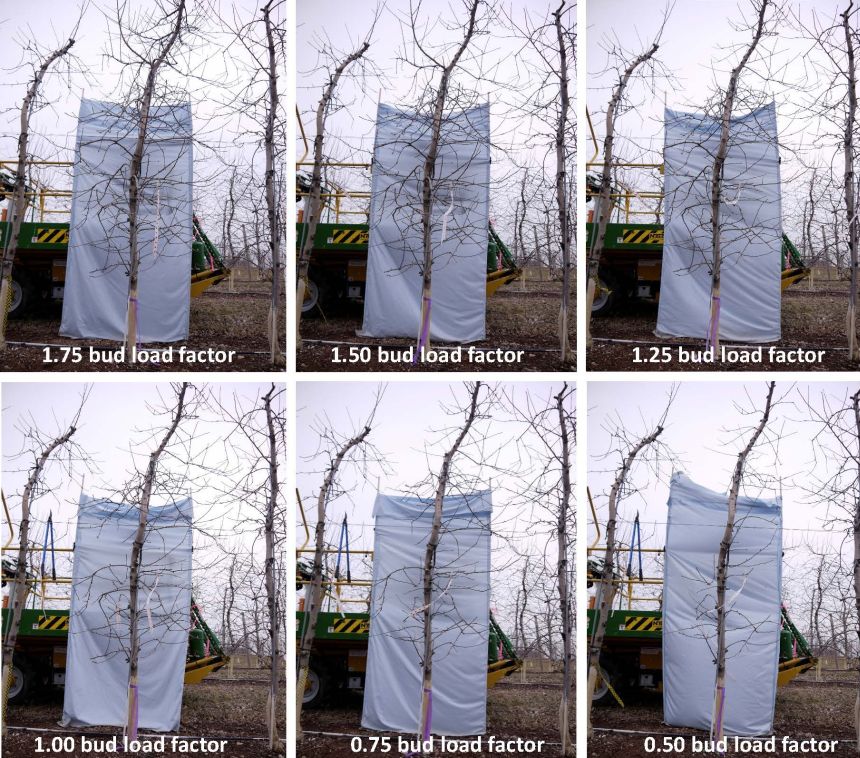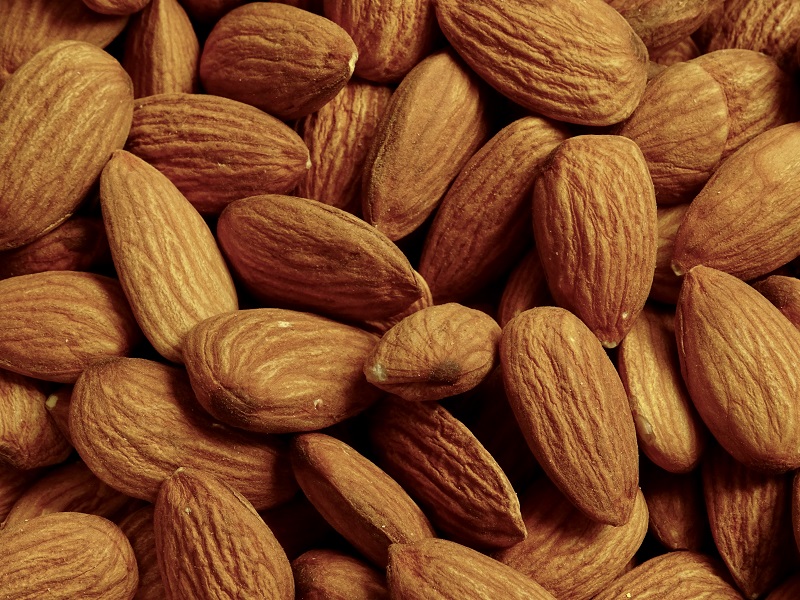Tips to Prune Smarter, Not Harder in Your Orchard
Precision pruning is a strategy to reduce the flower bud number per tree to a predefined flower bud number through pruning. It begins with counting the number of flower buds on a few representative trees per orchard. To help you through pruning decisions this offseason, use the exercise and follow the calculations as shown in this article.
In the past, the lack of uniformity of semi-dwarf trees and the massive number of buds on a tree made accurately counting buds impractical if not impossible.
Today it is practical to count the number of flower buds on representative trees in high density plantings. The precision pruning exercise for five mature trees (including counting and pruning) should not take you more than two hours. I recommend you make accurate fruiting bud counts by using a hand tally counter. It costs approximately $12 dollars at an office supply store.
It’s a Numbers Game
Knowing the number of flower buds per tree allows you to reduce initial flower bud numbers by pruning off excess fruit buds and only keeping those needed to set an adequate crop. In addition, you have the ability to select individual buds through selective pruning, retaining only those that are of the highest quality.
By pruning to a specified bud number, you can start the process of fruit thinning to better target the specific fruit sizes of the highest value fruit. Reducing the number of fruit buds on the tree early through pruning can reduce competition among flower and fruitlets, resulting in increased resources for the remaining fruit and improved fruit size and quality.
Determining the “target” bud numbers per tree depends both on the desired yield and fruit size, but also on the level of risk you are willing to accept. It is possible to use pruning to reduce fruiting buds to nearly the exact level required to set one fruit per spur for a full crop. However, I suggest that additional buds be retained to account for natural factors that cause buds not to set, such as frost or freeze, poor pollination, and poor flower viability.
The number of additional buds required to provide “insurance” will depend on the variety. For example, early blooming varieties may be more at risk for frost damage and you may want to keep more buds on than late-blooming varieties that have a lower risk of fruitlet loss. Thus, the number of buds to leave on the tree after pruning is based on the target number of fruits adjusted by a bud load factor that will provide some insurance buds.
A Precision Pruning Exercise
Follow these simple steps for a “Precision Pruning Exercise” you can conduct this winter.
1. Select five uniform trees per variety per block. (In this exercise we have used mature ‘Gala’ trees.) Select trees randomly in representative areas of the orchard. It is important to count each variety within the block separately since different cropping levels and growth habit will result in different number of buds per tree and the resulting pruning severity.
2. Count and record the entire number of fruit buds on each of the selected trees and calculate the average number of fruit buds per tree.
| Tree # | Number of fruit buds |
| 1 | 500 |
| 2 | 450 |
| 3 | 480 |
| 4 | 380 |
| 5 | 420 |
Calculations:
Average: 2,230 fruit buds / 5 trees = 446 fruit buds / tree
3. Calculate the target number of apples per tree to produce the yield of specific size fruit you want to target.
Calculations:
Target Number fruit/tree
= 1,500 bushels per acre X 100 apples per bushel
= 150,000 apples per acre
= 150,000 apples per acre divided by 1,210 trees per acre
= 124 apples per tree
| Orchard | Mature ‘Gala’ trees on M.9 rootstock |
| Planting density | 3-by-12 feet (1,210 trees to the acre) |
| Target yield | 1,500 bushels per acre |
| Target fruit size | 100-count size (100 apples/bushel) |
4. Multiply the target number of fruits by a bud load factor “BLF” of 1.5 (recommended BLF for ‘Gala’) to determine the number of fruit buds that should be left on each tree to achieve the desired yield with some insurance buds. The following table includes five more BLFs for you to see and compare different levels of fruit bud loads imposed to the same tree through precision pruning.
Calculations:
Target number fruit buds that need to be left on the tree after precision pruning (using a bud load factor of 1.5 for Gala):
= 124 fruit buds per tree X 1.50 (Bud load factor) = 186 fruit buds per tree (see fourth column of chart below, row 3)
| Average number of fruit buds/tree | Target number of fruit/tree | Bud load factor “BLF” | Target number of fruit buds to be left on the tree after precision pruning |
Pruning job (Number of fruit buds to be removed via pruning) |
| 446 | 124 | 1.75 | 217 | 229 |
| 446 | 124 | 1.50 | 186 | 260 |
| 446 | 124 | 1.25 | 155 | 291 |
| 446 | 124 | 1.00 | 124 | 322 |
| 446 | 124 | 0.75 | 93 | 353 |
| 446 | 124 | 0.50 | 62 | 384 |

Photographed is the same apple tree pruned to six different fruit bud loads by using a “bud load factor or BLF” from 1.75 (photo 1) to 0.25 (photo 6). (Photos credit: Jim Schupp, Penn State)
5. Prune to remove excess buds above that target bud number.
Pruning job:
= 446 fruit buds per tree – 186 fruit buds per tree = 260 fruit buds per tree (see fifth column, row 3)
The pruning can best be done by using the three rules of tall spindle pruning:
- Cut the leader at the optimum height (90% of between-row spacing) to a lateral branch;
- remove one to three large limbs with a bevel cut for renewal; and
- columnarize or simplify the remaining branches by cutting off large secondary lateral branches.
This initial pruning should be followed with a more detailed pruning of removing inferior buds to reduce bud load to the target level. Removing buds should be done selectively by removing first those buds that are of poor quality or positioned so that they will produce lower-quality fruit, such as those that are on pendant wood or small diameter wood.
6. After pruning, recount bud numbers of five representative trees to assess success of pruning and readjust pruning methods to better reflect target levels. Regularly reassess pruning to ensure that target bud levels are being achieved.
Different people, weather conditions, etc. can result in drifting away from the original goal and pruning methods will need to be readjusted through time.
The benefit of using precision pruning is that we can implement this practice today to achieve higher profit levels. And with higher-density orchards and uniform trees it should be a simple procedure to tag and count bud numbers for each variety in each orchard, estimating the pruning that should be done with very little risk or cost. It becomes more difficult as orchard tree numbers decline and vigor increases.
I encourage you to prune the moneymakers —‘Fuji,’ ‘Honeycrisp,’ and ‘Gala’ — via precision pruning this winter. We at Cornell Cooperative Extension are currently suggesting that Northeastern fruit growers prune using a bud load factor of 1.5 fruit buds for each final fruit number for ‘Gala.’ ‘Honeycrisp’ and ‘Fuji’ trees should be pruned with a bud load factor of 1.8.










